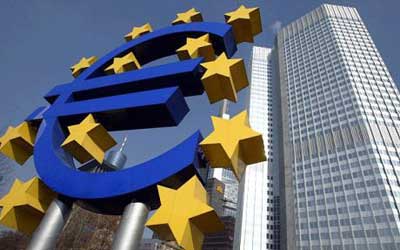Sunday Feb 23, 2025
Sunday Feb 23, 2025
Thursday, 14 May 2015 01:09 - - {{hitsCtrl.values.hits}}
 A slowdown in Germany weighed on the euro zone in the first quarter, but the bloc’s economy still grew at its fastest in almost two years as cheap food and fuel boosted spending and a central bank stimulus program kicked in.
A slowdown in Germany weighed on the euro zone in the first quarter, but the bloc’s economy still grew at its fastest in almost two years as cheap food and fuel boosted spending and a central bank stimulus program kicked in.
Gross domestic product in the 19 countries sharing the euro rose 0.4% quarter-on-quarter for a 1.0% year-on-year rise - just below forecasts in a Reuters poll of economists.
European Union statistics office Eurostat gave no detailed breakdown with Wednesday’s data, while economists said growth was likely to have been helped by lower food and energy prices, a weak euro and the asset-buying program the European Central Bank started in early March.
“It is evident that improved growth was due to strengthened domestic demand. Domestic demand was certainly behind the improved growth in France and Italy, and it also reportedly held up reasonably well in Germany,” said Howard Archer, economist at IHS Global Insight.
Overall, however, growth in Europe’s largest, and traditionally export-led, economy Germany slowed more than expected as imports rose more sharply than sales abroad.
That net drag from trade activity was replicated across the bloc as muted global growth curbed export growth despite a weaker euro, Archer said.
Germany’s GDP grew 0.3% on the quarter, down from 0.7% in the previous three months and undershooting a consensus forecast of 0.5% in a Reuters poll.
“Weak global trade is hitting German industry ... and if the consumers start refraining from spending too, overall economic growth will decline rapidly,” said Thomas Gitzel, chief economist at VP Bank.
The growth rate was half that of neighbouring France, the bloc’s No.2 economy, which expanded by 0.6%, its strongest rate in two years, boosted by a 0.8% rise in consumer spending.
Finance Minister Michel Sapin said the French economy would now grow faster than the 1% the government had forecast for 2015.
Archer said it was likely that consumer spending was a significant growth driver across the region and that investment strengthened in a number of countries, helped by improved business confidence.
Higher inventories were also likely to have contributed to growth.
Quarterly growth in the euro zone was the strongest since the second quarter of 2013 and marked a steady acceleration over the growth rates of 2014.Marco Valli, chief euro zone economist at UniCredit, said the same pace of growth should be maintained in the current quarter as waning support from oil prices should be compensated by a stronger impact from the weak euro.
“We think the euro zone has reached cruising speed of 1.5-2.0% annualised (growth), with favourable developments in oil prices and the exchange rate more than offsetting ongoing weakness in global trade,” he said.
Economists said the faster euro zone growth and an end to a run of negative inflation numbers in April were unlikely to stop the ECB’s money printing programme.
The Central Bank, which aims to lift euro zone inflation expectations back to its target rate of just below 2%, has repeatedly said it has no plans to end the quantitative easing scheme before its scheduled conclusion in September 2016.
The euro zone’s third biggest economy Italy grew 0.3% quarter on quarter, slightly more than expected thanks to a pick-up in domestic demand, fuelling hopes of a recovery this year after three years of recession.
Discover Kapruka, the leading online shopping platform in Sri Lanka, where you can conveniently send Gifts and Flowers to your loved ones for any event including Valentine ’s Day. Explore a wide range of popular Shopping Categories on Kapruka, including Toys, Groceries, Electronics, Birthday Cakes, Fruits, Chocolates, Flower Bouquets, Clothing, Watches, Lingerie, Gift Sets and Jewellery. Also if you’re interested in selling with Kapruka, Partner Central by Kapruka is the best solution to start with. Moreover, through Kapruka Global Shop, you can also enjoy the convenience of purchasing products from renowned platforms like Amazon and eBay and have them delivered to Sri Lanka.
Discover Kapruka, the leading online shopping platform in Sri Lanka, where you can conveniently send Gifts and Flowers to your loved ones for any event including Valentine ’s Day. Explore a wide range of popular Shopping Categories on Kapruka, including Toys, Groceries, Electronics, Birthday Cakes, Fruits, Chocolates, Flower Bouquets, Clothing, Watches, Lingerie, Gift Sets and Jewellery. Also if you’re interested in selling with Kapruka, Partner Central by Kapruka is the best solution to start with. Moreover, through Kapruka Global Shop, you can also enjoy the convenience of purchasing products from renowned platforms like Amazon and eBay and have them delivered to Sri Lanka.